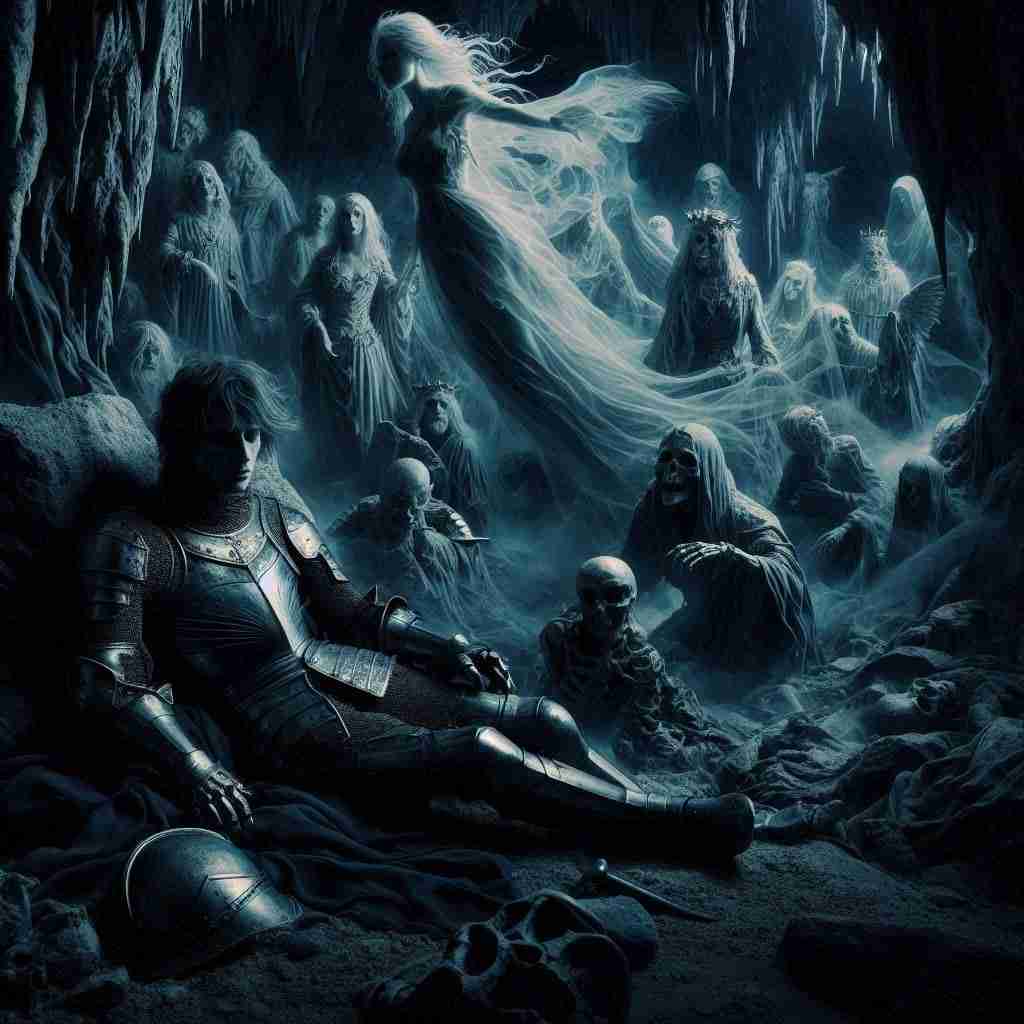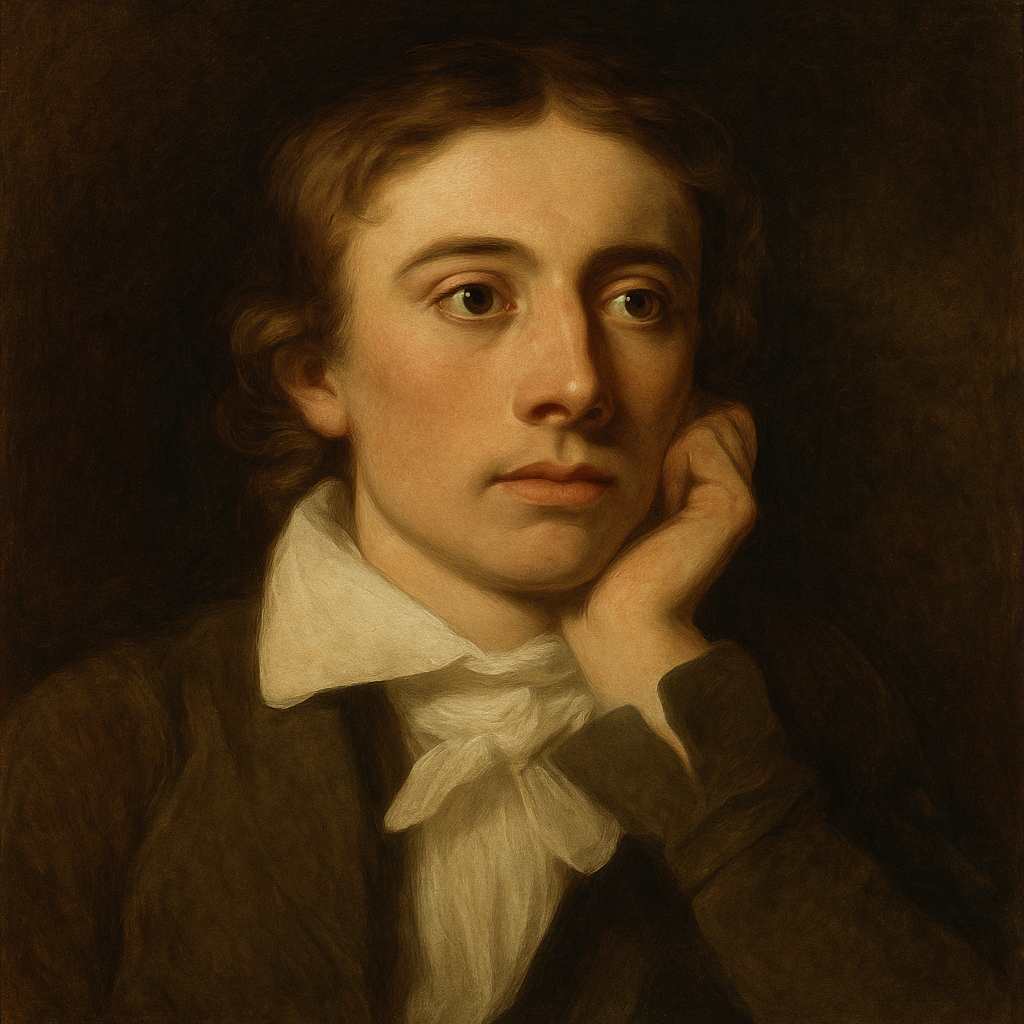La Belle Dame sans Merci: A Ballad
John Keats
1795 to 1821

O what can ail thee, knight-at-arms,
Alone and palely loitering?
The sedge has withered from the lake,
And no birds sing.
O what can ail thee, knight-at-arms,
So haggard and so woe-begone?
The squirrel’s granary is full,
And the harvest’s done.
I see a lily on thy brow,
With anguish moist and fever-dew,
And on thy cheeks a fading rose
Fast withereth too.
I met a lady in the meads,
Full beautiful—a faery’s child,
Her hair was long, her foot was light,
And her eyes were wild.
I made a garland for her head,
And bracelets too, and fragrant zone;
She looked at me as she did love,
And made sweet moan
I set her on my pacing steed,
And nothing else saw all day long,
For sidelong would she bend, and sing
A faery’s song.
She found me roots of relish sweet,
And honey wild, and manna-dew,
And sure in language strange she said—
‘I love thee true’.
She took me to her Elfin grot,
And there she wept and sighed full sore,
And there I shut her wild wild eyes
With kisses four.
And there she lullèd me asleep,
And there I dreamed—Ah! woe betide!—
The latest dream I ever dreamt
On the cold hill side.
I saw pale kings and princes too,
Pale warriors, death-pale were they all;
They cried—‘La Belle Dame sans Merci
Thee hath in thrall!’
I saw their starved lips in the gloam,
With horrid warning gapèd wide,
And I awoke and found me here,
On the cold hill’s side.
And this is why I sojourn here,
Alone and palely loitering,
Though the sedge is withered from the lake,
And no birds sing.
John Keats's La Belle Dame sans Merci: A Ballad
Introduction
John Keats's "La Belle Dame sans Merci: A Ballad" stands as a quintessential example of Romantic poetry, blending elements of medieval balladry with the haunting imagery and emotional intensity characteristic of Keats's oeuvre. This poem, composed in 1819, encapsulates the Romantic preoccupation with nature, love, and the supernatural, while simultaneously exploring themes of seduction, abandonment, and the perilous nature of desire. Through its intricate structure and evocative language, Keats crafts a narrative that transcends its apparent simplicity, inviting readers into a world where the boundaries between reality and fantasy, ecstasy and despair, are beautifully blurred.
Historical and Literary Context
To fully appreciate "La Belle Dame sans Merci," one must consider its place within the broader context of Romantic literature and Keats's own artistic development. The poem's title, borrowed from a 15th-century French poem by Alain Chartier, immediately situates it within a tradition of courtly love literature. However, Keats subverts this tradition, transforming the medieval allegory into a deeply psychological exploration of love's destructive potential.
The composition of this ballad coincides with a period of intense creativity and personal turmoil in Keats's life. Written in the same year as his great odes, "La Belle Dame sans Merci" reflects the poet's growing preoccupation with themes of mortality, beauty, and the transient nature of human experience. These concerns would come to dominate his later works, making this poem a crucial bridge between his earlier, more conventional pieces and the mature masterpieces that would secure his place in the literary canon.
Structure and Form
The poem's structure is deceptively simple, consisting of twelve quatrains with an ABCB rhyme scheme. This choice of form is significant, echoing the traditional ballad meter and lending the poem an air of folkloric authenticity. However, Keats subtly modifies the traditional ballad structure by alternating between eight-syllable and six-syllable lines, creating a rhythmic tension that mirrors the thematic tensions within the poem.
This structural choice serves multiple purposes. Firstly, it establishes a hypnotic cadence that draws the reader into the knight's tale, mimicking the seductive power of the belle dame herself. Secondly, the alternation between longer and shorter lines creates a sense of incompleteness or truncation, reflecting the knight's own truncated happiness and the abrupt end to his enchantment.
Narrative Technique and Voice
Keats employs a complex narrative structure in "La Belle Dame sans Merci," utilizing multiple voices and perspectives to create a layered and ambiguous tale. The poem opens with an unnamed speaker questioning the knight, establishing a frame narrative that immediately draws the reader into the story's mystery. This technique not only creates suspense but also introduces an element of unreliability – we are hearing the knight's tale secondhand, filtered through his own potentially compromised perception.
The shift to the knight's first-person narrative in the fourth stanza marks a crucial transition, immersing us in his subjective experience. This immersion is key to the poem's emotional impact, allowing readers to experience the knight's initial enchantment and subsequent disillusionment alongside him. The return to the original speaker's voice in the final stanza creates a circular structure, emphasizing the knight's entrapment in his melancholic state.
Imagery and Symbolism
The poem is replete with rich, evocative imagery that serves to create a dreamlike atmosphere while simultaneously conveying deeper thematic concerns. The opening stanzas establish a backdrop of autumnal decay – the withered sedge, the silent birds, the full granary – which not only sets a melancholic tone but also symbolizes the fading of passion and the inevitable passage of time.
The description of the knight himself, with his "lily" brow and "fading rose" cheeks, presents a striking image of beauty tinged with sickness or death. This juxtaposition of beauty and decay is a recurring motif in Keats's work, reflecting his fascination with the interplay between pleasure and pain, life and death.
The belle dame is described in terms that emphasize her otherworldly nature – "a faery's child" with "wild" eyes. This characterization places her firmly within the realm of the supernatural, aligning her with the femme fatale figures of folklore and myth. The garland, bracelets, and "fragrant zone" (belt) that the knight creates for her can be seen as attempts to domesticate or possess her wild nature, efforts that ultimately prove futile.
Themes and Interpretation
At its core, "La Belle Dame sans Merci" is an exploration of the power and peril of desire. The belle dame represents an idealized, almost platonic form of beauty and love, one that proves irresistible to the knight. However, this idealization is revealed to be a dangerous illusion. The knight's pursuit of transcendent love leads not to fulfillment but to a kind of living death, trapped between the memory of ecstasy and the reality of loss.
The poem can be read as a commentary on the artistic process itself, with the belle dame symbolizing the elusive muse or the unattainable ideal of perfect beauty. In this interpretation, the knight's fate serves as a warning about the dangers of becoming too absorbed in artistic or romantic pursuits at the expense of engaging with the real world.
Another significant theme is the tension between the natural and supernatural worlds. The belle dame, with her otherworldly origins and magical powers, represents a force that disrupts the natural order. Her seduction of the knight can be seen as a transgression of boundaries, leading to dire consequences. This theme reflects the Romantic fascination with the supernatural as a source of both wonder and terror.
Language and Sound
Keats's mastery of language is on full display in "La Belle Dame sans Merci." The poem's sonic qualities are carefully crafted to enhance its emotional impact. The prevalence of soft consonants and long vowel sounds in phrases like "alone and palely loitering" creates a languid, dreamy atmosphere that mirrors the knight's entranced state.
Conversely, the harsh consonants and staccato rhythm of "starved lips in the gloam" in the penultimate stanza serve to jolt the reader out of this reverie, emphasizing the horrific nature of the knight's vision. This careful modulation of sound and rhythm demonstrates Keats's exceptional skill in using the auditory qualities of language to reinforce meaning and emotion.
Influence and Legacy
"La Belle Dame sans Merci" has exerted a significant influence on subsequent literature and art. Its themes and imagery have been echoed in works ranging from Pre-Raphaelite paintings to modern fantasy literature. The poem's exploration of the femme fatale archetype has been particularly influential, prefiguring later treatments of this theme in literature and popular culture.
Moreover, the poem's ambiguity and psychological depth have made it a rich subject for critical interpretation. Scholars have approached it from various perspectives, including psychoanalytic, feminist, and historicist readings, each uncovering new layers of meaning within Keats's deceptively simple ballad.
Conclusion
In "La Belle Dame sans Merci," John Keats creates a work of remarkable complexity and emotional power. Through its intricate interplay of form, imagery, and theme, the poem offers a profound meditation on love, desire, and the human condition. It stands as a testament to Keats's poetic genius, demonstrating his ability to infuse traditional forms with new life and to explore universal themes in deeply personal and affecting ways.
The enduring appeal of "La Belle Dame sans Merci" lies in its ability to speak to fundamental human experiences – the allure of the ideal, the pain of loss, the tension between dream and reality – in language that is at once beautiful and haunting. As readers, we are drawn into the knight's tale, experiencing his enchantment and desolation as our own. In this way, Keats's poem transcends its specific historical and literary context, continuing to resonate with audiences across time and culture, inviting endless reinterpretation and reflection.
This text was generated by AI and is for reference only. Learn more
Want to join the discussion? Reopen or create a unique username to comment. No personal details required!



Comments
No comments yet. Be the first to comment!